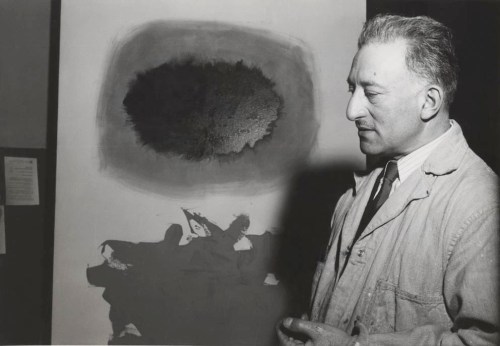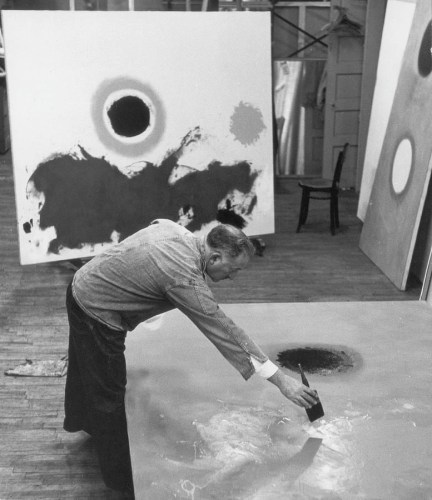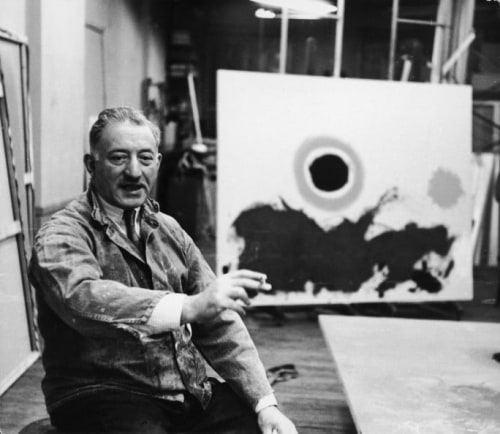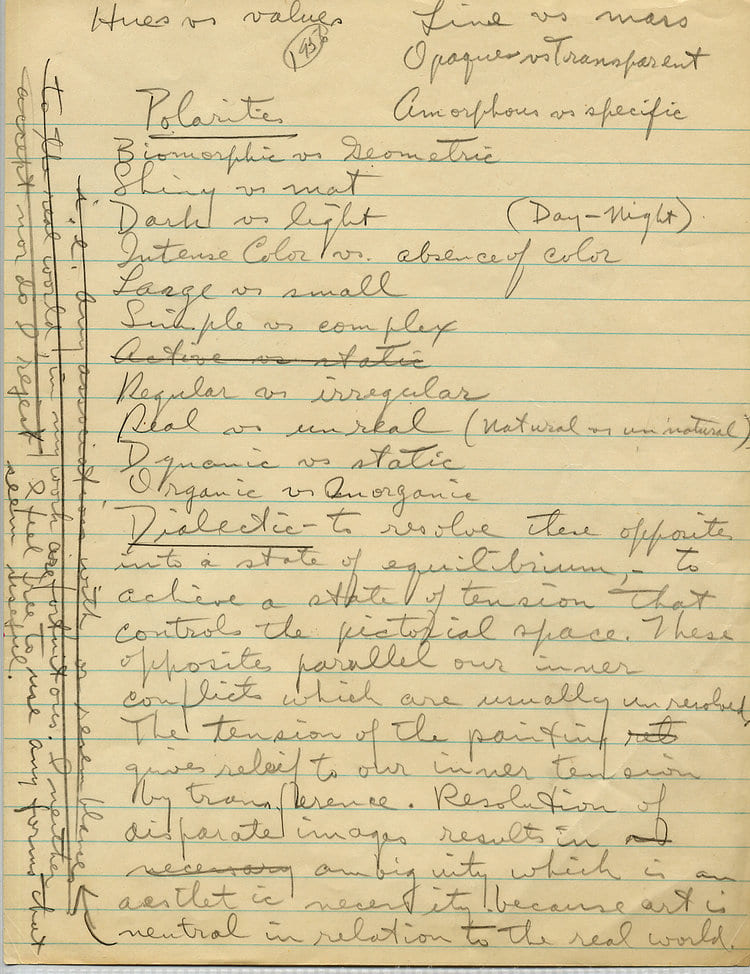Adolph Gottlieb, Polychrome Maze, 1956-1958
12/21/2020
Adolph Gottlieb
“When I say I am reaching for a totality of vision, I mean that I take the things I know – hand, nose, art – and use them in my paintings after separating them from their associations as anatomy. I use them as a totality of what they mean to me.…It puts us at the beginning of seeing.”
- Adolph Gottlieb, quoted in Limited Edition, December 1945

Adolph Gottlieb in front of one of his canvases, 1958. Photo courtesy of the Adolph & Esther Gottlieb Foundation. Artwork © Estate of Adolph and Esther Gottlieb / Artists Rights Society (ARS), New York.
Painted between 1956 and 1958, Adolph Gottlieb's Polychrome Maze belongs to the artist's significant Imaginary Landscapes series. As is typical of works from this group, Polychrome Maze is rendered as an abstracted, emotionally charged pseudo-landscape; the canvas is bisected into zones of earth and sky, demarcated by a notable horizon line, creating an earthly reference atypical of the work of his fellow Abstract Expressionists. Below, feverishly painted brushstrokes fill up the lower register as spots of primary colors peek out from underneath them. These strokes of deep black paint recall Gottlieb's earlier series of Pictographs, for which he initially achieved notoriety, and which began many of the philosophical and intellectual themes he would carry through to his Imaginary Landscapes and Burst paintings. Above, a more pared-down scene emerges as three ovoid shapes hover weightlessly on a light-yellow ground. Despite the hints at a real-world relationship between figure and ground, there is an apparent lack of suggestion of perspectival space. Instead, the composition's flatness is welded together through this certain but inexpressible relationship between the shapes and their support.

Adolph Gottlieb working in his Chelsea studio, New York, February 16, 1962. Photo by Fred W. McDarrah/Getty Images. Artwork © Estate of Adolph and Esther Gottlieb / Artists Rights Society (ARS), New York.
The Imaginary Landscapes, including Polychrome Maze, provide an incredibly insightful summation of much of Gottlieb's artistic motivations. When he began the series in 1951, the concept of the "all-over" composition had come to dominate discourse amongst Abstract Expressionists. However, Gottlieb saw this painterly device as cliché and, determined to explore new theories of abstraction, ventured to break away from this direction. For Gottlieb, what mattered most was how successfully his paintings could convey emotional truth and quality of feeling. However, Gottlieb still assigned a great deal of intellectual rationalization to his compositions. Elaborating on this stance in a 1962 interview with Martin Friedman, Gottlieb stated, "Actually, if I were asked to say what I mean by feeling, I would say that feeling is everything that I've experienced and thought. It isn't purely just feeling in the emotional sense, in the sense of feeling joy or grief or any specific emotion. It's really, as I see it, an attempt to express abstractly almost all my experience which is emotional. And, at the same time, I attach a great deal of importance to the thought process and a kind of intellectual approach to painting; and I can't separate them." (Gottlieb quoted in an interview with Martin Friedman, August 1962, courtesy of the Adolph & Esther Gottlieb Foundation).

Portrait of Adolph Gottlieb in his Chelsea studio, New York, February 16, 1962. Photo by Fred W. McDarrah/Getty Images. Artwork © Estate of Adolph and Esther Gottlieb / Artists Rights Society (ARS), New York
The year Gottlieb began Polychrome Maze, 1956, was crucial for further artistic breakthroughs and professional development. 1956 was both the year Gottlieb started his relationship with the Martha Jackson Gallery and the year he secured a retrospective at the Jewish Museum in New York. This year would likewise see Gottlieb paint his first Burst paintings, a series of works with a natural lineage to the Imaginary Landscapes: the brushier, more densely populated areas are parsed down into ethereal cloud-like forms. As for his philosophical leanings, Gottlieb penned a series of notes titled Polarities, where he weighed the balance of opposites observed in areas such as science, abstract thinking, and personal psychology, concluding that successful works of art depend on the balance and interplay between these contrasting forces. As the Brooklyn Rail notes: "By engaging in this line of thinking, his explorations of 1956 produced a richer body of work than any other single year of his career; works from that year contain the seeds for all Gottlieb's paintings of the next seventeen years." ("Adolph Gottlieb: Polarities" The Brooklyn Rail, 2016).

Excerpt from Adolph Gottlieb's notebook on "Polarities," 1956. Courtesy of the Adolph & Esther Gottlieb Foundation.
“... my aim has always been to project images that seem vital to me, never to make paintings that conform to the pattern of an external standard.”
- Adolph Gottlieb, quoted in The New Decade: 35 American Painters and Sculptors, exh. cat., Whitney Museum of American Art, 1955

